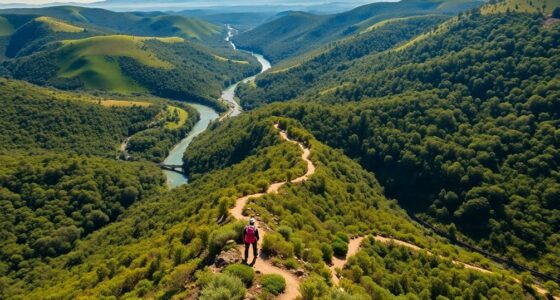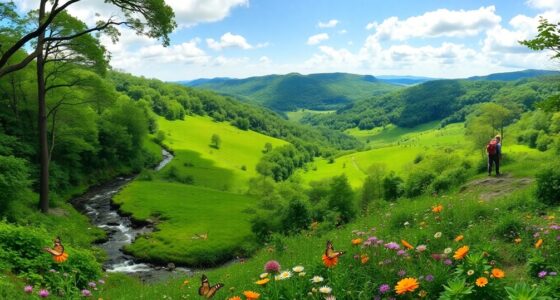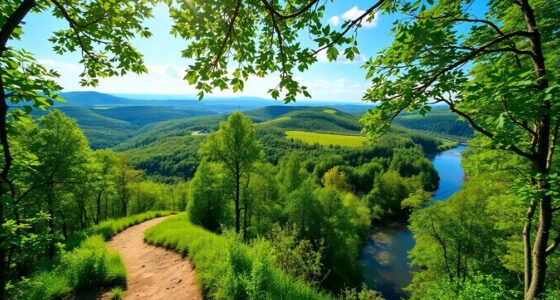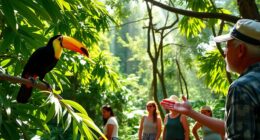Alaska's green wonders invite you to explore stunning landscapes while embracing sustainable adventures. You can engage in wildlife-friendly tours that prioritize conservation and learn from local guides about the unique ecosystems. Consider kayaking to observe marine life with minimal impact or staying at solar-powered lodges that reduce your carbon footprint. Seasonal events, like the Midnight Sun phenomenon, enhance your experience with long days for exploration. Plus, community initiatives promote recycling and environmental awareness. By immersing yourself in these sustainable practices, you'll not only enjoy Alaska's beauty but also contribute to its preservation—there's even more to discover in this incredible landscape!
Key Takeaways
- Explore Alaska's diverse ecosystems through wildlife-friendly tours that prioritize animal welfare and conservation practices.
- Experience sustainable lodging in solar-powered lodges with locally sourced culinary experiences that support the local economy.
- Discover glaciers and natural landscapes like Denali and Kenai Fjords National Parks while engaging in eco-friendly activities and guided eco-tours.
- Participate in seasonal tourism events that promote sustainable practices and celebrate local culture, such as summer solstice festivals.
- Utilize public transit options like the Alaska Marine Highway System for scenic travel while reducing your carbon footprint.
Introduction
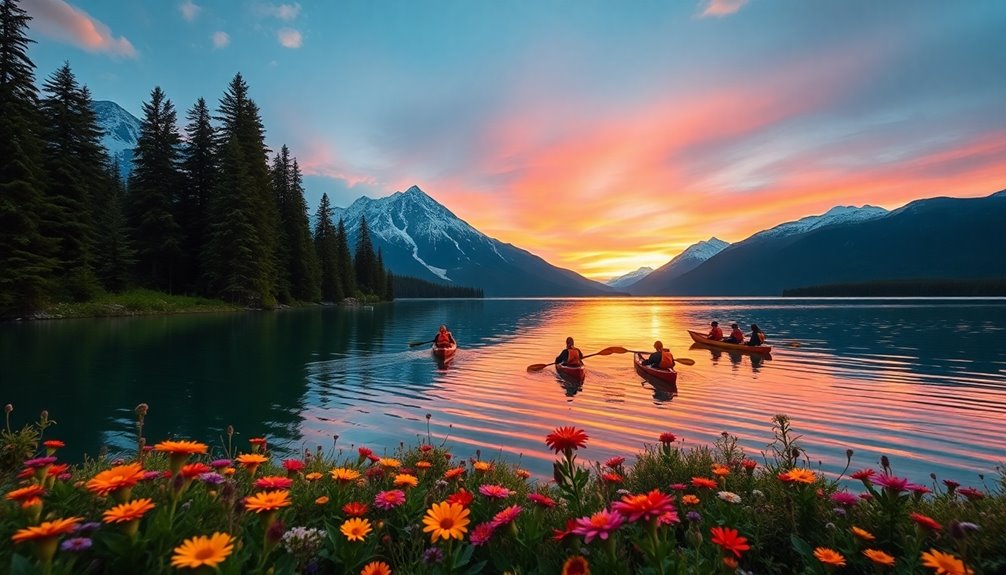
When you step into Alaska's vast wilderness, you'll encounter breathtaking landscapes and diverse wildlife that few places can match.
The stunning glaciers and rugged terrain create a backdrop for unforgettable experiences while you explore nature responsibly.
Vast Wilderness and Diverse Wildlife
As you venture into Alaska's vast wilderness, you'll discover over 663,000 square miles of breathtaking landscapes that beckon outdoor enthusiasts.
Here, you'll experience thrilling wildlife encounters with approximately 50,000 moose, 30,000 brown bears, and over 800 species of birds.
Each unique ecosystem, from coastal rainforests to tundra, offers habitats for a rich variety of flora and fauna, including endangered species like the Steller's eider and the polar bear.
With 16 national parks dedicated to preserving these vital habitats, you'll have plenty of opportunities for exploration.
Just remember, engaging with Alaska's wildlife requires careful consideration to ensure you practice responsible observation.
Your commitment to conservation helps protect this extraordinary environment for future generations.
Breathtaking Glaciers and Landscapes
Alaska's stunning wilderness isn't just limited to its diverse wildlife; it's also defined by its breathtaking glaciers and landscapes. With over 100,000 glaciers covering about 5% of the state, you'll find stunning natural beauty at every turn.
Marvel at the iconic Margerie Glacier in Glacier Bay National Park, where you can witness spectacular calving events as massive ice chunks crash into the water.
Denali National Park offers breathtaking views of Denali Mountain, surrounded by expansive glacial landscapes perfect for hiking.
Don't miss Kenai Fjords National Park, home to accessible coastal glaciers like the Exit Glacier.
As you explore, remember that glacial retreat signals climate change, reminding us of the fragile balance between nature and our actions.
Travel From Seattle to Alaska

When you're planning your trip to Alaska, Seattle is a great starting point.
You can choose from quick flights or scenic cruises that whisk you away to breathtaking landscapes.
If you're up for an adventure, consider taking the ferry or even driving the Alaska Highway for a unique experience.
Travel From California to Alaska
Wondering how to get from California to the stunning landscapes of Alaska? You can start by booking a direct flight, which typically takes about 5 to 6 hours to cities like Anchorage or Juneau.
If you're after a scenic adventure, consider a cruise ship that offers breathtaking views and stops at charming ports along the coast.
Alternatively, the Alaska Marine Highway System's ferry services provide a unique way to experience the coastline while visiting various ports.
No matter how you travel, remember to embrace sustainable practices inspired by the Leave No Trace Center.
Whether exploring national parks or enjoying a picturesque drive, your journey can reflect a commitment to preserving Alaska's natural beauty for future generations.
Flights From London to Alaska
Traveling from London to Alaska opens up a world of breathtaking landscapes and unique adventures.
While there aren't direct flights from London to Alaska, you can easily connect through major U.S. hubs like Seattle or Los Angeles. Expect your journey to take around 9 to 10 hours to Seattle, followed by a 3 to 4-hour domestic flight to your Alaskan destination.
Major airlines, including British Airways and Alaska Airlines, offer various options that cater to your budget. Seattle-Tacoma International Airport serves as your primary gateway, providing numerous daily flights to cities like Anchorage and Fairbanks.
To make the most of your trip, consider booking your flights in advance, especially if you plan to explore the stunning routes of the Alaska Railroad. Additionally, understanding the cruise industry's evolution can enhance your travel planning and experience in Alaska.
Flights From Sydney to Alaska
Flying from Sydney to Alaska often means you'll have to make a layover, typically in Seattle or another major U.S. city.
The total travel time averages around 18 to 25 hours, depending on your layover duration. Major airlines like Alaska Airlines, Qantas, and American Airlines offer multiple flights from Sydney to Alaska each week, connecting you to stunning destinations like Denali National Park.
Once in Seattle, a direct flight to Anchorage or Fairbanks takes about 3 to 4 hours, covering roughly 2,200 miles.
To get the best rates, especially during peak tourist seasons, it's wise to book well in advance. Round-trip fares from Seattle to Anchorage generally range from $200 to $600, depending on various factors.
Public Transit Options Available
While planning your journey from Seattle to Alaska, you'll find a variety of public transit options that cater to different preferences and budgets. From scenic ferry rides to efficient flights, the Last Frontier is accessible in many ways. Here's a quick overview:
| Transit Option | Duration/Details |
|---|---|
| Alaska Marine Highway | Scenic ferry rides to various ports |
| Greyhound Buses | Multiple connections to Anchorage & Fairbanks |
| Amtrak Cascades + Ferry | Train to Vancouver, then ferry to Alaska |
| Direct Flights | About 3.5 hours to major cities like Anchorage and Juneau |
Consider carpooling or ridesharing to reach your departure point economically. Each option offers a unique way to experience the journey to Alaska!
Sustainable Wildlife Viewing Opportunities
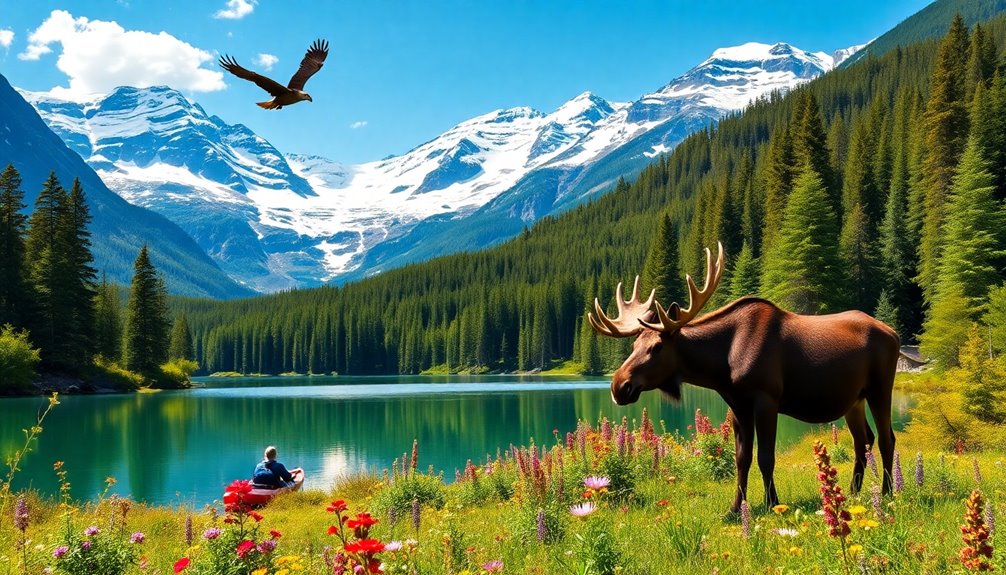
When you explore Alaska, consider wildlife-friendly tour options that prioritize animal welfare and conservation.
Kayaking excursions let you observe marine life up close while minimizing your impact on the environment.
Plus, staying in solar-powered lodges enhances your eco-adventure, ensuring a sustainable experience in this breathtaking landscape.
Wildlife-Friendly Tour Options
Alaska offers countless wildlife-friendly tour options that allow you to experience the state's rich biodiversity without compromising its fragile ecosystems.
Many operators, like Above & Beyond Alaska, are Adventure Green Alaska certified, ensuring eco-friendly practices that prioritize responsible wildlife viewing. These guided experiences not only educate you on species behaviors—such as brown bears and humpback whales—but also emphasize ecological conservation.
Seasonal tours align with wildlife migrations, granting you unique opportunities to witness events like salmon runs while minimizing habitat disruption. Engaging in interactive activities, such as guided photography or kayaking, promotes low-impact observation methods.
Plus, local guides share cultural insights, enhancing your connection to Alaska's natural environment and its indigenous conservation practices. Understanding the ecological conservation principles can deepen your appreciation for Alaska's wildlife and the importance of protecting their habitats.
Wildlife-Friendly Kayaking Excursions
Exploring the stunning waterways of Alaska through wildlife-friendly kayaking excursions offers an eco-conscious way to connect with nature.
You'll have the chance to observe fascinating marine life, like playful sea otters and seals, while ensuring you don't disturb their natural habitats. These tours follow responsible wildlife viewing guidelines, keeping a safe distance from animals during critical life stages such as breeding and feeding.
Many kayaking operators are Adventure Green Alaska certified, highlighting their commitment to sustainable practices and local conservation efforts. Guided trips often include educational insights from local experts, enriching your experience with knowledge about the unique ecosystems you're paddling through.
Solar-Powered Lodging Options
After experiencing the thrill of wildlife-friendly kayaking, consider enhancing your adventure with a stay at one of Alaska's solar-powered lodges.
These eco-friendly accommodations utilize solar panels to significantly reduce their carbon footprint while offering you comfortable lodging. Blending seamlessly into the breathtaking landscape, these lodges often feature sustainable materials that minimize environmental impact.
You'll find prime wildlife viewing opportunities right outside your door, allowing you to observe local fauna without disturbing their habitats.
Many solar-powered lodges also offer guided eco-tours, enriching your experience by educating you on local ecosystems and wildlife conservation efforts. Additionally, these lodges often implement solar energy solutions to further enhance their sustainability efforts and reduce reliance on traditional energy sources.
Responsible Wildlife Interaction Guidelines

How can you ensure a safe and respectful wildlife encounter during your Alaskan adventures? By following a few simple guidelines, you can enjoy wildlife viewing while protecting these majestic creatures.
Always maintain a safe distance—at least 100 yards from bears and 25 yards from moose. Use binoculars or zoom lenses to observe wildlife, preserving their natural behavior. Stick to designated trails to minimize habitat disruption.
- Refrain from feeding wildlife to prevent dependency on human food.
- Participate in guided tours with certified professionals who emphasize responsible wildlife observation.
- Respect local regulations and wildlife habitats to keep them thriving.
Community-Led Recycling Programs

In Alaska, community-led recycling programs highlight the power of local action in promoting sustainability.
You'll see how government and NGO efforts work hand-in-hand with residents to foster cultural responsibility and reduce waste.
Join your neighbors in these initiatives and experience the positive impact you can make together.
Government and NGO Efforts
While many Alaskan communities strive for sustainability, government and NGO efforts have sparked a remarkable transformation in recycling practices.
Community-led recycling programs are now more accessible, with over 50 designated recycling centers across the state. Non-profit organizations, like the Alaska Conservation Foundation, are vital in funding grassroots initiatives and enhancing public awareness.
You can help by engaging with local efforts, which include:
- Educational campaigns that boost recycling rates by 25% in five years.
- Collaboration between local governments and NGOs to empower communities.
- Resources and training for establishing your own recycling projects.
Together, these initiatives foster a sense of ownership and responsibility towards the environment, making Alaska a leader in sustainable practices.
Community and Cultural Sustainability
As communities across Alaska embrace sustainable practices, local-led recycling programs are becoming vital in reducing waste and fostering environmental stewardship. These initiatives are often tailored to meet the unique needs of each community, especially in rural areas with limited waste disposal options. Local organizations lead educational campaigns, involving schools and groups to promote a culture of sustainability.
Here's a visual representation of community-led recycling efforts:
| Focus Area | Initiative | Impact |
|---|---|---|
| Waste Reduction | Community recycling drop-off sites | Less landfill waste |
| Education | Workshops and school programs | Increased awareness |
| Circular Economy | Repurposing materials | Support for local artisans |
Together, these efforts create a stronger community committed to sustainable practices and environmental care.
Summer Solstice for Longer Days
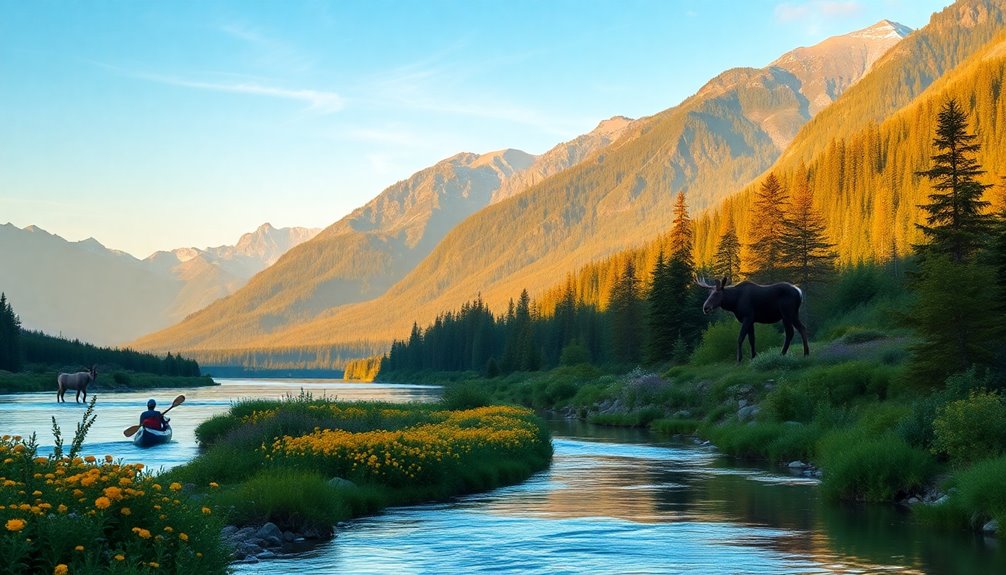
When the summer solstice hits around June 21, you'll experience the magic of the midnight sun, especially in northern Alaska.
With up to 24 hours of daylight, you can take advantage of the warm temperatures to explore the stunning landscape and observe wildlife in their vibrant habitats.
This unique phenomenon not only enhances your outdoor adventures but also influences the local ecosystem, making it a perfect time for sustainable tourism.
Midnight Sun in Summer
The Midnight Sun transforms Alaska into a playground of endless possibilities during the summer solstice, around June 21st.
With almost 24 hours of daylight, you can embrace adventure and explore the stunning natural beauty that surrounds you. This phenomenon is especially pronounced in regions above the Arctic Circle, like Barrow, where the sun graces the sky for about 80 consecutive days.
- Engage in outdoor activities like hiking, fishing, and kayaking.
- Experience vibrant local festivals celebrating this unique cultural event.
- Witness flourishing ecosystems as plants and wildlife thrive under extended daylight.
The Midnight Sun not only enhances your adventures but also supports sustainable tourism, allowing you to connect deeply with Alaska's breathtaking landscapes.
Seasonal Temperature Variations
During the summer solstice, you'll experience Alaska's remarkable transformation, with nearly 24 hours of daylight in many regions. This extended sunlight boosts average temperatures to a comfortable range of 60°F to 80°F (15°C to 27°C) along the coast, making it perfect for outdoor adventures.
In places like Fairbanks, you'll enjoy about 22 hours of daylight, with the sun barely dipping below the horizon.
These seasonal temperature variations not only enhance tourism but also trigger a burst of biological activity. Wildlife thrives, engaging in mating and feeding, while native plants flourish under the sun's nurturing rays.
How to Make Your Trip More Sustainable

To make your trip more sustainable, start by packing biodegradable toiletries and utensils to minimize your waste.
Choose locally sourced food options to support the community and reduce your carbon footprint.
Every small choice you make can contribute to preserving Alaska's stunning landscapes for future generations.
Biodegradable Toiletries and Utensils
While exploring the breathtaking landscapes of Alaska, opting for biodegradable toiletries and utensils can significantly reduce your environmental impact.
These eco-friendly products, like shampoo bars and bamboo toothbrushes, naturally decompose, minimizing waste and pollution in Alaska's pristine environments. Additionally, using compostable utensils made from cornstarch or wheat straw helps preserve the stunning scenery.
- Biodegradable toiletries often contain fewer harmful chemicals, protecting both your health and local wildlife.
- Lightweight and travel-friendly options make them perfect for hiking and camping.
- Supporting sustainable practices aligns with Alaska's commitment to environmental stewardship.
- Many portable camping toilets are designed to accommodate eco-friendly disposal methods, further enhancing your sustainable camping experience.
Locally Sourced Food Choices
Choosing locally sourced food during your Alaskan adventure not only tantalizes your taste buds but also supports sustainable practices and the local economy.
Dive into Alaska's culinary experiences by savoring fresh seafood like salmon and halibut, often caught by local fishermen. Many restaurants partner with local farms, ensuring your meals feature ingredients that reduce food transportation's carbon footprint.
Consider joining a farm-to-table tour, where you'll enjoy dishes crafted from produce harvested nearby, deepening your connection to the land.
Don't miss local food festivals and markets, where you can taste and purchase sustainably produced goods. Engaging with local chefs through cooking classes gives you insight into sustainable practices while celebrating the rich cultural heritage of Alaskan cuisine.
Frequently Asked Questions
Is Alaska Really the Last Frontier?
Yes, Alaska is often called "The Last Frontier" because of its vast, untamed wilderness.
When you explore its rugged landscapes—towering mountains, dense forests, and pristine national parks—you'll see why this nickname fits.
The state's remote areas remain largely untouched, offering a glimpse into a world where nature thrives.
With a rich cultural heritage and unique ecosystems, you'll find that Alaska truly embodies the spirit of adventure and frontier living.
Can You Visit Alaska the Last Frontier?
Absolutely, you can visit Alaska, home to over 3 million lakes!
Imagine standing beside shimmering waters, surrounded by majestic mountains and vast wilderness.
With its stunning national parks, like Denali, you can hike, kayak, or even dog sled.
Plus, you'll find numerous eco-friendly tour operators dedicated to preserving this breathtaking landscape.
Thanks to Alaska Airlines, getting there's easier than ever, connecting you to unforgettable adventures in the Last Frontier.
Conclusion
As you plan your sustainable adventure in Alaska, you might worry about the impact of your travel. But remember, every small step counts. By choosing eco-friendly options, supporting local communities, and embracing responsible wildlife interactions, you're not just enjoying nature; you're helping preserve it for future generations. Picture the pristine landscapes and vibrant wildlife thriving because of your choices. Isn't it worth it to experience Alaska's wonders while protecting its beauty? Your journey can make a difference!




